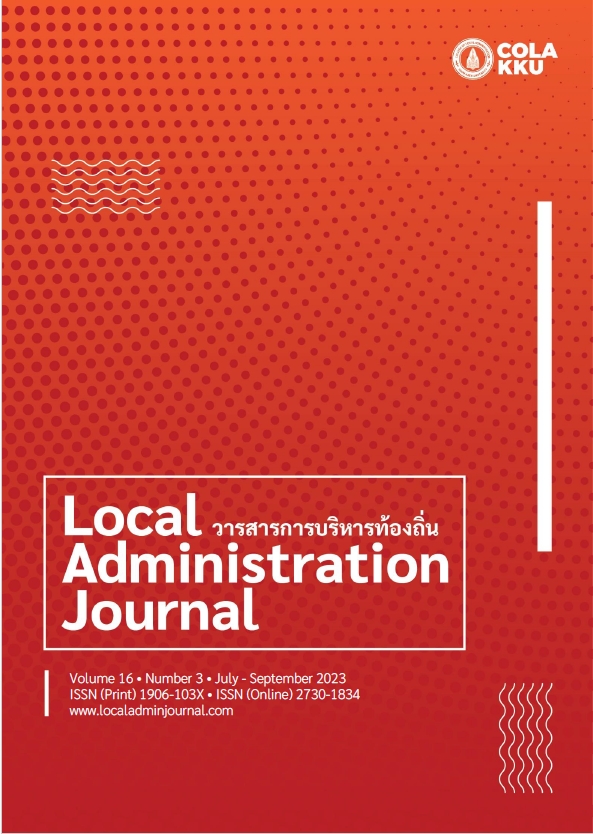Land Use Changes Among Rice Farmers Following the Implementation of Subsidization Policies: A Case Study of Mek Dam Village, Phayakkhaphum Phisai District, Maha Sarakham Province
Keywords:
Land uses, Conditions under which land uses change, Changes in land usesAbstract
This study investigated changes in land use patterns among rice farmers in Mek Dam Villege, Mek Dam Sub-district, Phayakkhaphum Phisai District, Maha Sarakham Province. The research aimed to assess the effects of the government's subsidization and supportive programs for rice farmers on land use during the crop years 2019/2020 and 2020/2021. Additionally, the study explored other conditions, beyond government programs, that influenced land use decisions. Data were collected through questionnaires and interviews and analyzed using frequency distribution, percentages, and standard deviation. The findings show variability in land use decisions: while a majority of Mek Dam farmers persisted in rice cultivation, a notable minority transitioned to post-harvest crops, with some adopting 'the New Theory Agriculture'. Factors prompting changes in land use included water scarcity, drainage issues, and soil degradation. Interestingly, other factors highlighted in existing literature – economic conditions (e.g., rising costs of chemical fertilizers and fuel), institutional conditions (e.g., land ownership and allocation), socio-cultural factors (e.g., land-use perceptions), and technological aspects (e.g., information access for agricultural development) – appeared to have no influence on land use changes in the studied community.
References
Amphan, D. (1988). Principles of land use. Faculty of Forestry, Department of Conservation, Kasetsart University. (in Thai)
Bangkok Business News Online. (2021). Commerce rushes to solve the problem of falling rice prices, emphasize to farmers not to worry, there is guaranteed income compensation. Retrieved from https://www.bangkokbiznews.com/business/970114.
Bank for Agriculture and Agricultural Cooperative. (2019). "Harvest Cost Assistance and Rice Quality Improvement Initiative - Production Year 2019/20" was initiated to assist farmers with harvest costs and enhance rice quality. Retrieved from https://shorturl.asia/vY4C9.
Borras Jr, Cristóbal Kay, Sergio Gómez & John Wilkinson. (2012). Land grabbing and global capitalist accumulation: key features in Latin America. Canadian Journal of Development Studies/Revue Canadienne d'études du développement, 33(4), 402-416.
Borras, S. M. & Franco, J. C. (2012). Global Land Grabbing and trajectories of agrarian change: a preliminary analysis. Journal of Agrarian Change, 12(1), 34-59.
Buason, R. (2015). Qualitative research in education (5th ed.). Bangkok: Chulalongkorn University. (in Thai)
Chuchip, K. (1989). A Study of Land Use Conditions and Plant Society Analysis to Analyze the Situation of Doi Inthanon National Park,
Chiang Mai Province. Kasetsart University Knowledge Repository. Bangkok: National Research Council of Thailand (NRCT). (in Thai)
Department of Internal Trade. (2019). Interest compensation project for rice traders in stock keeping. Retrieved from https://www.opsmoac.go.th/news-files-412891791144.
Kantri, N. & Laiprakobsup, Th. (2018). Problems in implementing policies to help farmers in the areas reported from Suphan Buri Province. Bangkok: Chulalongkorn University Social Research Institute. (in Thai)
Klindaw, S. (2007). Remote sensing: introductory digital image processing. Bangkok: Odeon store. (in Thai)
Khuprakhon, K. (1999). Land Economics (2nd ed). Bangkok: Ramkhamhaeng University. (in Thai)
Kumpetch, P. & Kongruang, Ch. (2016). The determination of Agricultural Land Use in Northern Thailand Case study: Areas planted paddy. Journal of Business, Economics and Communications. 11(1), 113-121. (in Thai)
Lhabthanaroj, Th. (2019). Land use and area management in Ko Samet, Rayong. Retrieved from: https://repository.nida.ac.th/handle/662723737/5116.
Manorom, K. (2016). The situation of struggle, ownership, and land use in the Isan border area. Ubon Ratchathani: Mekong Sub-Region Social Research Center [MSSRC]. (in Thai)
Ngamlamom, W. & Thirasirikul, J. (2018). The Evaluation of Helping Farmer Policy in The Case of the Spending 1,000 Baht Per Rai for Farmers Project in Surin Province. The Liberal Arts Journal, Mahidol University, 1(2), 83–99. (in Thai)
Pintobtang, P. (2020). Adaptation of Thai Farmers in The Post-Pledged Rice Policy Era, 2014. (Chulalongkorn University Social Research Institute). Retrieved from https://shorturl.asia/E58yG.
Sribunkhum, A. (2021). Prediction of Land use Change in Lam Dom Yai Subwatershed. Burapha Science Journal, 26 (3), 1,777-1,795. (in Thai)
Thai PBS News. (2022). Thung Kula farmers oppose sugar factory-biomass power plant Concerned about the impact of GI jasmine rice. Retrieved from https://thecitizen.plus/node/65540.
Tiamthongbai, et al. (2023). Changes in Land Use Patterns by Farmers in Huai Pong Village, Mae Tuen Sub-district, Mae Ramat District, Tak Province. Thai Journal of Forestry 42(1), 12-22. (in Thai)
Wongtawan, N. (2006). Socio-Economic Factors Effective Land Use Change: A Case Study of Villages Around Dong Payayen-Khao Yia Forest Complex. (pp. 7-8). Kasetsart University Knowledge Repository. (in Thai)
Yamane, T. (1967). Statistics: An introductory analysis (2nd ed). New York: Harper and Row.
Downloads
Published
How to Cite
Issue
Section
License
Copyright (c) 2023 Local Administration Journal

This work is licensed under a Creative Commons Attribution-NonCommercial-NoDerivatives 4.0 International License.
The copyright of all articles published in the Local Administration Journalis owned by the College of Local Administration, Khon Kaen University.



